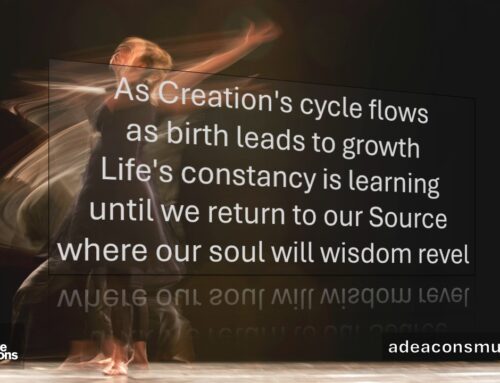Vignette: A Statistic Waiting to Happen
As with all stories,
this may not have actually happened,
but all stories are true.
And as story-tellers know,
once you hear them,
they are happening to you. . .
The boxes sat on his desk and office chair. Most were already taped shut and all he had to do was take them to the trunk of his car after the party. He put down the tape and began to put the last few things into the remaining open box.
He looked at the closed boxes and the one that remained open with a certain sense of finality, perhaps even fragility. In each were the memories of a career that had seen many changes and shifts. There were relationships captured by each picture, stories of transformation implicit in each file. In each memento, tears and laughter, joy and loss danced. There weren’t a lot of things that he needed or even wanted to keep, but these few tokens felt like enough.
He could hear them down the hall; the traditional “send-off”was underway. Between the sounds of laughter, he could hear his name being called. He would miss this place, but his doctor had said that it was time that he considered a different pace. He wasn’t sure what the diagnosis might mean as he entered retirement, but Melanie had told him they would figure it out. There had been tears, but finally he had heard her. Perhaps he was simply trying to convince himself that she and the doctor were right . . . regardless, it was time.
As he stared at the last picture to be packed, he realised in that one image his entire career, he liked the word vocation, in the justice field was encapsulated. A journey from enforcement and laws to one in which there was more grey and ambiguity. When he first took his oath to protect and serve, it was pretty clear what that meant: bad guys got what they deserved and law-abiding citizens had to be protected from dark streets and cagey people.
It had been an era, those first few years, in which a little force could loosen tongues and get results. Of course, he remembered that even with tongues loosened, he kept seeing the same faces in the rear-view mirror of his squad car. Seeing those faces, perhaps they had a new tattoo or scar, always seemed . . . to be despairing? Even lost, he would wonder? He never could describe what it was, but whatever the word, it was what finally brought him to the Restorative Justice Branch.
He was sceptical, but it was part of the role, he would later reflect. The training he had to work the street was not originally concerned with talking things out. When he was dispatched, the lights flashed, and his job was to stop the crime in progress. It wasn’t even a consideration to address the underlying causes, which he would never have thought about anyways. That changed over the years in this office, he noted.
Kim (the director at the time) listened to him, his frustration and his lament that no matter how many hours he tried to put in, he wasn’t making a difference. She patiently let him reflect and wrestle with how force didn’t seem to change anyone, and all that he could figure out was that he was simply getting angrier and more prone to violence.
He even, reluctantly, admitted that sometimes he worried he was becoming the very thing that he had hoped to stop. He hated admitting that to her, but it was like he was infected by the job. He offered this confession hoping she might understand. Gratefully, holding that picture, he remembered that she did.
Looking at the picture of a bright sun-shine-filled beach at the edge of an ocean, he stood with his arm around a boy: no, man, he corrected himself. That man, Charles, stood tall above him and his long, braided hair spoke of a deep pride for his First Nation: Nehiyaw—Cree tradition and culture. Remembering that day, embraced by the warm sun, he knew that when they first met, pride and confidence were the last things Charles possessed. In fact, the first time they met, Charles was simply another statistic waiting to happen.
Charles was just another young Aboriginal boy, arrested for a “break & enter.” The victim was an elderly woman by the name of Mrs. Clementia. Charles’ crime would lead to his graduation into the penal system, a system that Larry’s career had taught him meant if Charles ever got out, he would be in his forties with no prospects. Larry knew the colonial history, and what that meant, but understanding it didn’t change the fact that Charles and his people were always playing a game in which the rules had been stacked against them. At one time, when he was on the streets working the beat, he knew he was one of the reasons Charles was meant to lose.
Though he was a statistic waiting to happen, Charles was Larry’s first assigned mediation after he transferred to Branch. He went through the training, working with Elders and non-Aboriginal practitioners; he learned more about the social causes and problems affecting people who often had their cases redirected to the Branch. He even had to accept that too often what he did when he was on the street was social work, not law enforcement. That realisation, however, only reminded him how ill equipped most of his peers actually were after leaving the Academy.
He knew he was initially resistant to the idea that he had anything to do with the poverty and challenges that came with a lack of education or job options. He hated that he had to look into the mirror of his own privilege.
There was a point when he was about to quit when Kim reminded him what had brought him to the Branch: if he really wanted to make a difference, it would mean he would probably have to wrestle with the fact that the blacks and whites of a constable’s work would have to give way to the vagaries and ambiguity of the grey areas of people’s lives. It was something he would have to accept if he was to actually become a victim-offender mediator. And, she suggested, that began with him knowing his own privilege and realising how he, like all Settlers, benefitted from the system. It was hard to hear, but it finally sunk in.
Even with all of the training, he walked in with assumptions at his first meeting with Charles. The underlying causes and knowledge of the history of being on Treaty lands went straight out the window. The cop Larry had once been rudely trumped all the work he had done with Kim, the Elders, and other mediators.
Larry laughed now, picture in hand, recollecting that it was Charles’ own anger and frustration with being in that holding cell that allowed him to let go of those assumptions. It was easy to do, he thought to himself. When a yelling and crying young sixteen-year-old Cree boy sits sullenly, silently, and then, as a dam bursting, points at you with recrimination that this “mediation thing better fucking work, or else,” you sort of realise that not only are you part of the solution, but also that any solution can’t happen without trust. That trust took work, of that there was no denying. It began with Charles’ clear commitment to knowing that this was a sort of “last chance,” but it also took Larry to realise that Charles could not do it alone. The path to any resolution would require Larry to find ways to help Charles connect with a mentor if this were to work.
From that moment, he wasn’t sure whether it was him or Charles and Mrs. Clementia who actually helped that mediation unfold so well. There were utter failures, of course, as he often had to remind himself. No matter how many doors you open, an Elder once told him, you never help anyone by pushing them through.
But it was their willingness to actually listen to one another as they shared how their lives led them to the incident that brought them together: the B&E. Usually a B&E would result in the Crown Attorneys cutting a deal to expedite the process, which sometimes even resulted in shortened jail-time, if for no other reason than to alleviate the backlog. In this case, Charles and Mrs. Clementia did not meet in the courtroom divided by space, law and ritual.
During the mediation sessions, Charles and Mrs. Clementia were honest to the point of discomfort, at times, with one another, and some of those there to witness on behalf of the community. In their divulging, an amazing thing happened. In the mind of Mrs. C. as she became known to us, Charles shifted from a criminal to a young boy, on the verge of manhood, who made a set of bad mistakes, mistakes that now placed him at a crossroads.
Mrs. C. realised she was more than the “victim,” a sense that too often never leaves those who have been violated and experienced harm. And in the process, they walked toward their own resolution, something intrinsic to the victim-offender mediation journey. A resolution in which those involved decide what good looks like. Usually such reconciliation demonstrated that though something might begin in the irritation of conflict, there is the potential for a pearl!
He laughed, remembering the face of the RCMP constable and Crown Attorney as Mrs. C. suggested a resolution that not only had no real “precedent,” even in the mediation process, but that had no footing, per se, in the criminal justice realm! Though there could have been a challenge to this, Mrs. C. pointed out that even though the B&E had happened, there had been no damage and the items that Charles had stolen had been promptly returned unscathed. All she wanted were two things: a hug and an opportunity to pay for Charles’ art lessons! Everyone in that room, as Charles wept and his mother numbed by what seemed (initially) incomprehensible, were trying to process what had just occurred in that little office.
Larry always wondered what led Mrs. C. to that place of grace, where she shifted from retribution and restitution to something less tangible, maybe, but certainly more restorative. It was not that he did not accept or appreciate the shift, but at the time there seemed to be no logic to it. Over the years, as he reflected on this initial “success,” Larry came to realise that it was Charles’ reference to art in answering some of her questions that helped facilitate the outcome. When words failed him owing to the context of a troubled family with few economic options and where substance abuse was a constant temptation, Charles had learned to speak through his art. Charles’ art, Larry realised, was likely the catalyst.
A hug and paying for art classes for the boy who had violated her home was . . . humbling, he admitted. Later, removed from the emotion of the moment, the lawyers and RCMP would share their “displeasure” with him and the Branch. But then it felt like a thin moment, one in which something very special had transcended, even transformed, all of them.
He didn’t often get into that aspect of the work. It made him squirm a bit. Yet, in those quiet and honest moments, it’s why he remained so passionate about the work after that first experience. It’s when he realised that he could hold on to his ideals and make a difference, something he knew he would not be able to do had he stayed on the Force.
After that, Charles drifted out of his life. The Branch took on more and more work and continued to have to rationalise itself to a judicial system that too often wanted metrics of success that were simply not quantifiable with hugs, and he saw lives transformed when people chose to go through the doors. But the seeds in which he had a part planting did not become apparent as new growth. The potential of this work did not come into full view for him until that picture was taken two springs ago. It was when he and Melanie were trying to figure out what retirement would look like: hard to believe that was even before the recent results came back from the blood work, he realised.
He was standing there on the beach. Melanie had gone to check on their reservations, and he heard his name called in a deep voice of inquiry, “Larry?”
As he turned, in front of him was a tall man, well-toned and clearly confident. Even though it had been years, he still assessed danger in unexpected meetings and this was no different. As he noted the braid and evident health of this man, he was aware he was trying to figure out if this unknown man was a threat. As he processed the encounter, the man spoke once again: “Larry? Mr. Porter? It’s me, Charles.”
In that moment, in the power of a name to transport time, his face softened, eyes opened, and there, on a beach that could be anywhere, they embraced. An echo of the same hug that had once been shared between Mrs. C. and Charles decades previously.
After they had caught up, and Larry learned that Charles was there hosting an international indigenous art gathering, Melanie changed their reservation to include Charles and his spouse, Pat, and their two children, and Charles took him aside once more as they were leaving. What Charles said was the door for which Larry had been waiting as he wrestled with when might be the “right” time to leave the Branch:









Your reflections are most welcome!